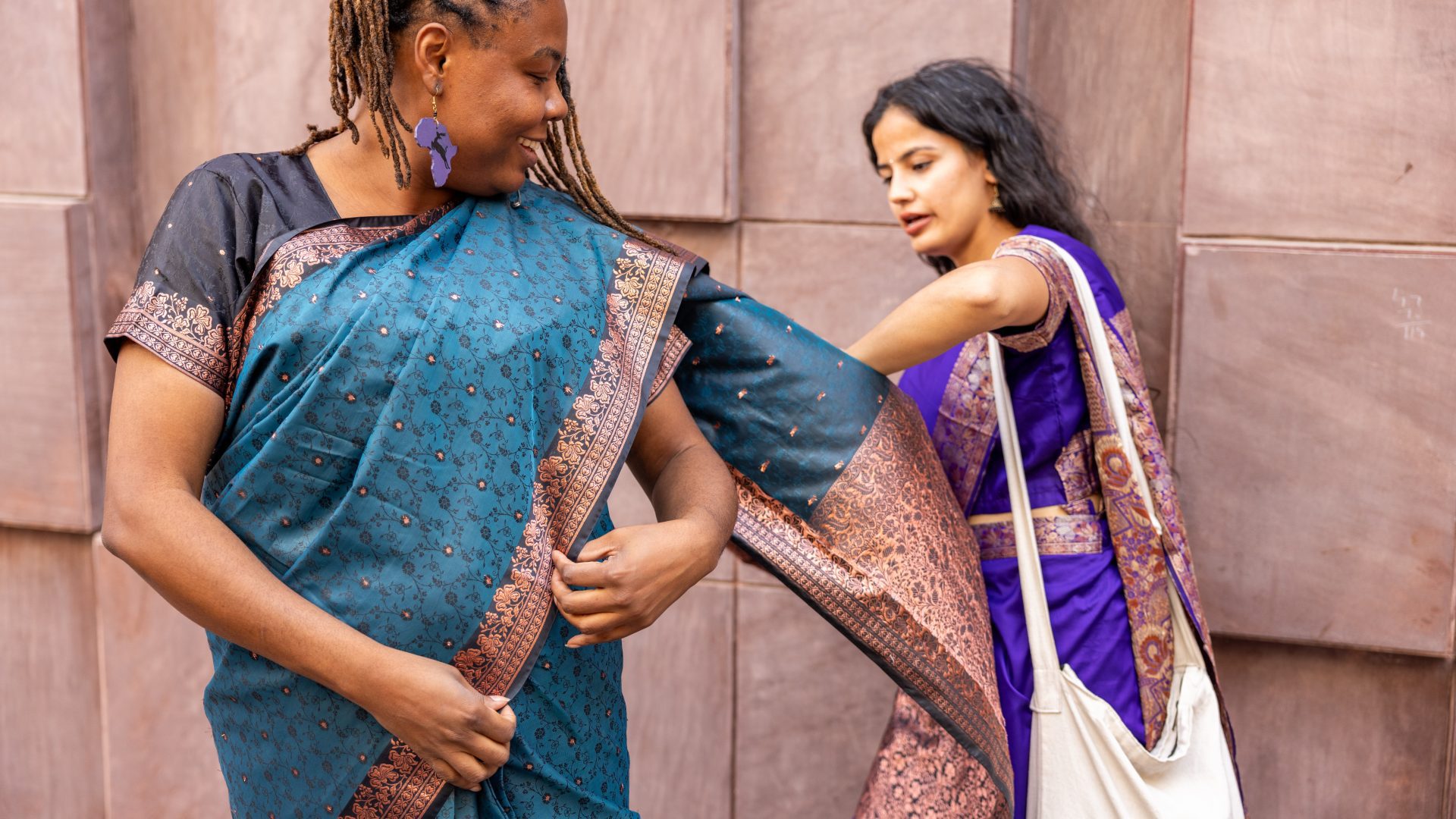Saree and turbans in India. Kimonos in Japan. Mantas and monteras in Peru. These are simply among the conventional garments travellers have a possibility to study on Intrepid journeys. It’s possible you’ll even wish to strive them on your self. However what’s the etiquette for guests who want to gown in conventional clothes?
Understanding the ‘proper’ factor to put on or not put on when travelling isn’t at all times apparent. The extra locations I’ve visited, the extra I’ve realized that researching the values and etiquette of the place I’m going is as essential to me when selecting clothes for the journey because the climate forecast.
Sporting conventional clothes from one other tradition is a special consideration solely.
After I came upon that my India Girls’s Expedition would come with the chance to decorate in a saree, I had many questions. All variations on, ‘Is that this… OK?’
The standard gown for Indian ladies is so stunning, and the chance to be taught extra about it sounded actually particular. However as a white North American customer, I admit I used to be frightened about how donning an area outfit is likely to be perceived. Appreciation? Or appropriation? The favored public service marketing campaign ‘My tradition will not be a fancy dress’ got here to thoughts.

‘We do acknowledge and perceive that with this exercise, a cautious and cautious method is required,’ says Rama Mahendru, common supervisor of Intrepid India.
‘As an alternative of simply handing ethnic put on over to our travellers immediately, we ensure our chief current is speaking in regards to the acceptable behaviours whereas wearing native put on. If we’re respectful and accountable, as Intrepid has at all times been, dressing up might be a tremendous expertise. It’s enjoyable, interactive and might join individuals higher.’
I used to be grateful to have a feminine Intrepid chief I may discuss to truthfully about my reservations. Anjali defined we might be visiting the house of an area lady to decide on a saree with their steering and discover ways to put it on, and he or she reassured our group that locals are appreciative of our curiosity and efforts to attach extra with their tradition.
I’ve realized that genuine interplay like this between visitors and locals is on the coronary heart of Intrepid’s actions involving conventional gown.
‘Conventional apparel has at all times been an enormous a part of tradition of a rustic,’ explains Rama. ‘On our journeys, we provide this expertise as a possibility for our visitors to be mingled with the tradition of the nation extra deeply… to attach them with the situation extra and enhance the native interplay.’
In India, there are three alternatives for Intrepid travellers to take part in one of these cultural trade. My group skilled this in Agra, the place ladies are supplied pre-stitched ready-to-wear sarees (a skirt, high and draping scarf). Conventional male kurta pyjamas are additionally accessible to put on for his or her go to to the Taj Mahal.
On the Traditional Rajasthan journey, visitors have the chance to put on conventional attire for a particular dinner at Fort Madhogarh, together with a lehnga (skirt), kurti (tunic) and odhni (scarf) for girls, whereas males could have turbans tied on their head.
Elsewhere in Asia, Intrepid’s Important Japan journey for 18 to 35s gives an optionally available kimono, maiko, or samurai rental in Kyoto. On Discover Taiwan teams go to the Indigenous Ayatal Tribe in Yilan and travellers can study and check out on their conventional garments. On the South Korea Household Vacation, adults and children are supplied with pants and a tunic to put on within the Golgulsa Temple, in accordance with the monastery’s gown code.
In South America, Peru Necessities incorporates a go to to the folklore capital of the nation on Lake Titicaca and features a homestay with the chance to put on in native Inca clothes, like mantas (shawls) and monteras (hats).
I feel again to my very own Intrepid journey in Morocco, and remorse that I didn’t reap the benefits of the supply to discover ways to tie a shesh (head scarf) in a conventional method for our camel trip throughout the Sahara. On the time, I wasn’t fairly satisfied it will be acceptable to try to gown like an area, so I tied my scarf myself. Spoiler: within the beautiful-but-oh-so-unforgiving desert setting, studying the Desert Means of doing issues is at all times a better thought than what you suppose !
It’s essential to notice that typically there are alternatives that don’t really feel proper, so in case you’re not sure it’s finest to observe your chief’s cues. In India, I witnessed photograph ops at common vacationer locations which positively felt extra like a humorous costume than a real cultural interplay. And Intrepid’s Tibet workers don’t advocate related photograph stops in Lhasa, the place conventional Tibetan clothes is usually not genuine, nor run by Tibetans themselves.
Having an area chief for this sort of expertise is useful not just for selecting clothes with care and understanding, but in addition for navigating any etiquette questions that will come up as you put on the clothes in public. Going to the Taj Mahal in a saree attracted much more consideration than I’m used to from locals, however after being suggested to satisfy their curiosity with a smile, the awkwardness disappeared.
I nonetheless consider it’s regular to have questions and issues earlier than dressing in conventional clothes as a traveller, however I’m additionally assured that attempting this out on an Intrepid journey, with the steering of a frontrunner, generally is a very constructive expertise for each guests and locals. (Dressing up can also be optionally available, in fact, so there’s no stress).
I look again at my images within the saree in India with a lot happiness figuring out that the once-in-a-lifetime expertise was instructional, joyful and, most significantly, respectful.
Uncover conventional experiences on an Intrepid small group adventures.

